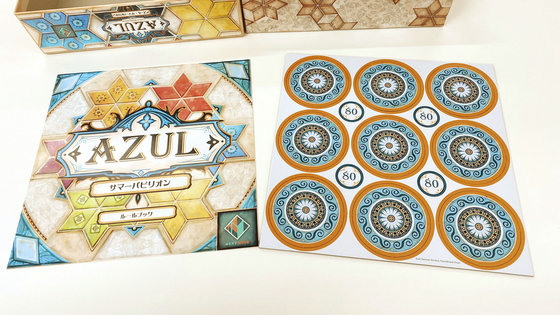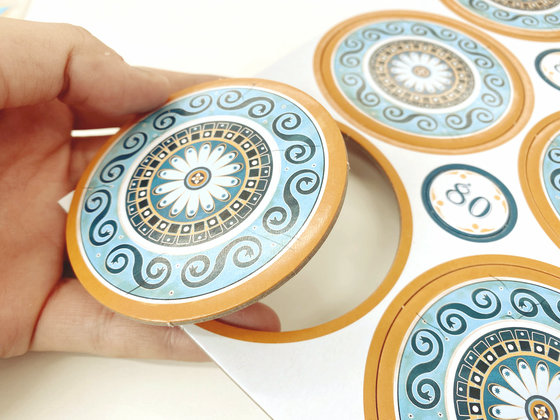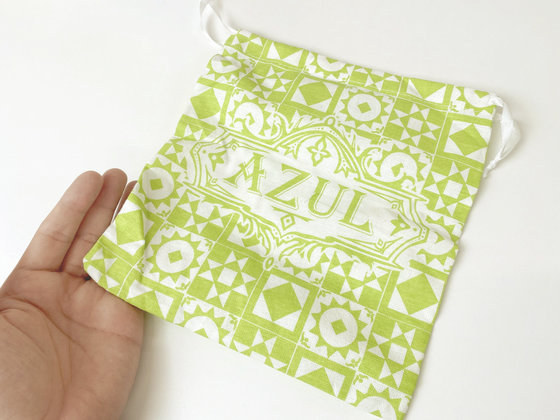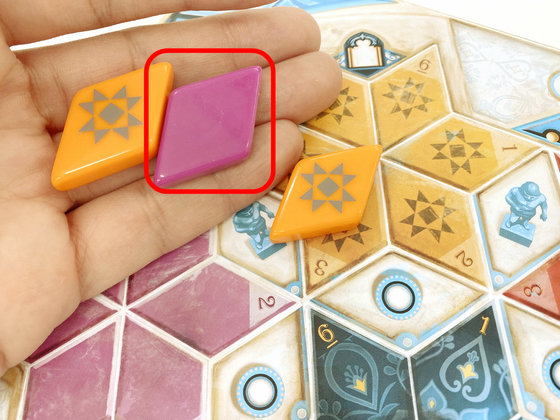'Azul: Summer Pavilion' review to create the most beautiful floor of the royal palace by arranging colorful diamond tiles

'Portugal of the king,
Azul: Summer Pavilion | | ANALOG GAME INDEX
http://hobbyjapan.games/azul_summer_pavilion/
◆ Contents
Azul's package looks like this.

The target age is 8 years old and over, the number of players is 2 to 4, and the play time is 30 to 45 minutes.

The contents are a rule book, a workshop exhibition board designed like a round ceramic plate, and a cardboard with a score token written as '80'.

Since the cardboard has cuts, it can be easily separated without using scissors or a cutter.

Score board and 4 workshop boards

The player board is adorned with colorful diamond-shaped spaces.

The long box in which tiles are thrown in the game is designed to imitate the tower of the royal palace. A sticker (on the left in the image) is attached to the tile holder ...

By sticking a sticker on the bottom, it will be reinforced so that the bottom will not come off even if a large amount of tiles are put in.

There are a total of 132 6-color diamond-shaped tiles that decorate the floor of the royal palace. There are 22 sheets per color.

Each tile color corresponds to the player board.

And the bag that holds the tiles looks like this.

Round marker, score marker, start player marker.

◆ Preparation for the game
First, arrange the workshop exhibition boards. This time we will play with 4 people, so 9 pieces are arranged in a circle.

We will distribute the workshop board to each player. The player color is displayed at the top of the studio board.

Place the player token in the '5' square on the scoring board and the round marker in the '1' location where the purple diamond is drawn.

Put all the tiles in the bag, shuffle them well, and then place 4 tiles per workshop exhibition board.

In addition, 10 tiles randomly taken out of the bag are placed in the space in the center of the scoring board.

Place the start player marker in the center of the workshop exhibition board, and the place where preparations are completed is as follows.

◆ I tried playing the basic rules with 4 people
The way to proceed with the game is very simple. The first round is divided into the 'Tile Acquisition ' phase, the ' Tile Placement ' phase, and the ' Next Preparation ' phase, and the game ends when the 6th round is completed. The person with the highest score at that time wins.
In the tile acquisition phase, tiles are acquired in order clockwise from the start player. Choose your favorite one from the workshop exhibition boards in the field.

Then choose only one color you like and get all the tiles. Place the tiles you did not get in the center of the circle. For example, in the following scene, if you get 3 blue tiles, 1 extra red tile will move to the center.

Also, the color of the place where the round marker is placed is called 'wild color'. For example, in the first round, purple becomes a wild color.

If there is a wild color tile on the workshop exhibition board, you can get it by adding only one to the tile of the color you originally got. For example, if you get an orange tile from the studio exhibition board that has 2 oranges, 1 cream, and 1 purple, you can get 2 oranges and 1 wild purple as well. You can only get one.

As players get tiles in order from the workshop exhibition board, tiles not selected by each player will gather in the center of the circle.

In the tile acquisition phase, you can get it not only from the workshop exhibition board but also from the center of the circle. Since only 4 tiles can be placed on the workshop exhibition board, you can only get up to 4 tiles at a time. However, tiles are gathering more and more in the center ...

As shown below, you can get as many as 5 tiles at once.

The person who first gets the tile from the center of the circle in the round can also get the start player marker in the center. If you get the start player marker, you can become the start player in the next round, so you can advance the game to your advantage ...

The person who wins the Start Player Marker will be deducted by the number of tiles earned at the same time. Therefore, when to reach the center of the circle is the bargain between players.

When all the tiles are gone from the workshop exhibition board and the center of the circle, the tile acquisition phase ends and the tile placement phase begins.

Colors and numbers are written in the space of the workshop board. For example, if you want to place tiles in orange 6, you need 6 or more tiles. Pick up all the orange tiles you have, make sure you have 6 or more, and place one of them in the space of the workshop board ...

All the remaining tiles are put into the tower.

You can get 1 point by placing 1 tile. Also, if multiple tiles are adjacent to each other in the placed space, you can get points for a series of adjacent tiles.

Also, wild tiles can be used as a substitute color. For example, if you want to place tiles in 3 orange spaces, you would normally need 3 or more orange tiles, but you can also place '2 orange tiles + 1 wild tile'. Will be.

Of course, the wild-colored tiles used are destined to be discarded in the tower. Wild-colored tiles are very convenient and are especially easy to reduce compared to other tiles, so it is inevitable that players will compete with each other.

In the tile placement phase, tiles are placed on the studio board one by one clockwise from the start player. Also, if you declare a 'pass' without placing tiles, you can place up to 4 tiles in the corner of the workshop board and carry them over to the next round. However, once you declare your pass, you can no longer place tiles in that round.

Once everyone has placed the tiles, remove the tiles from the bag and place them on the workshop display board again before moving on to the next round.

As I proceeded with the game like that, I succeeded in surrounding the statue on the studio board with tiles as shown below.

The workshop board has monuments such as pillars, statues, and windows, and by surrounding each with tiles, you can acquire additional tiles you like from the supply space in the center of the scoring board. It's a great advantage to be able to get tiles of your favorite color in this game, so it's very important to enclose the monuments to ensure that the floor of the royal palace is beautifully colored. If the tiles run out of the supply space, they will be randomly replenished on the spot.

The game ends when 6 rounds are over. Add additional points to the base points you get each time you place a tile, depending on how you place the tile. For example, if you complete an orange star, you will get 17 points.

However, it is quite difficult to complete. Only one of the four was able to complete the star, and the other three were almost only basic points. Players who have completed the stars are by far the best in collecting basic points during the game, and at the end of the game, they are considerably less motivated, saying, 'I can't reverse it no matter what I do, and I don't have all the tiles on the floor ...'. There was also a development.

◆ I tried playing additional rules with 3 people
This time I tried playing the additional rule with 3 people. Since there are 3 people, the number of workshop exhibition boards will be reduced to 7, and the workshop boards will be turned over and changed to additional rule specifications.

The studio board with additional rules does not specify the color to place the tiles, and the player can choose and place a single color star or multiple color stars by himself. However, you cannot put tiles of the same color in one star.

The editorial staff who played said, 'The basic rule specified how to place tiles, but the additional rule is that you can place tiles as you like and make floors as you like, so the creativity of the player It's inspiring. '

The following players who want to align the stars in the center of the workshop board have a lot of red tiles that are wild colors in the last round, but they do not have the essential blue tiles. If you align the stars in the center, you can get 12 points, so this is a place you definitely want to align.

Therefore, I devised a strategy to get blue tiles from the supply space in the center of the scoring board. However, looking at the supply space, there are no blue tiles.

So, we'll leave everything to the luck of 'surrounding the monument, getting tiles from the supply space, pulling out the blue tiles, and then surrounding another monument to get the blue tiles.'

The inside of the bag looks like this. This looks promising as the blue tiles were sleeping quite a bit.

However, when I replenished two tiles after getting the tiles from the supply space, one cream-colored tile and one orange-colored tile appeared.

I couldn't get luck on my side and I couldn't finish the central star in the end. Even so, by completing two stars, I succeeded in gaining 24 additional points and jumped to the top.

In addition, the player who was breathing 'I will have a single color star!' Was able to complete only one star in the end. You can get 16 cream-colored stars, but it's quite difficult to complete a monochromatic star, and it requires careful strategy and overwhelming luck.

◆ Impressions
Azul: When I actually played the Summer Pavilion, I got the impression that it was considerably more difficult than the first in the series, 'Azul.' The point of 'acquiring tiles from the workshop exhibition board and placing them at hand' is almost the same as the previous 'Azul' series, but with the change in the shape of the tiles and the introduction of wild colors, it is completely It has a different play feeling. The rules are simple, so even beginners of analog games can quickly get used to playing.
In the previous 'Azul' series, there was a rule that 'discarding the surplus tiles will result in a deduction', so it was important to 'acquire tiles so as not to exceed the required number'. However, Azul: The Summer Pavilion does not have that rule, so the impression that 'aiming at the timing of tile acquisition while bargaining with other players in the tile acquisition phase' is considerably thinned.
Also, the basic rules are quite restrictive to play, and the impression that the player's freedom of 'I want to make a beautiful floor of my own' and 'I want to complete a star' has dropped considerably. However, since the additional rules increase the degree of freedom, it is recommended to consider the basic rules as a tutorial to acquire how to play, and to play with the additional rules once you get used to the game.
In addition, the number of tiles is just right for 3 players, and 4 players may not have enough tiles to complete the stars, so some people may not get a sense of accomplishment. Therefore, I felt that Azul: Summer Pavilion is a game that is more enjoyable for 3 people than 4 people.
Azul: The Summer Pavilion is available on Amazon.co.jp and can be purchased for 6100 yen including tax at the time of writing the article.
Amazon | Azul: Summer Pavilion Japanese Edition | Board Games | Toys

Related Posts:







